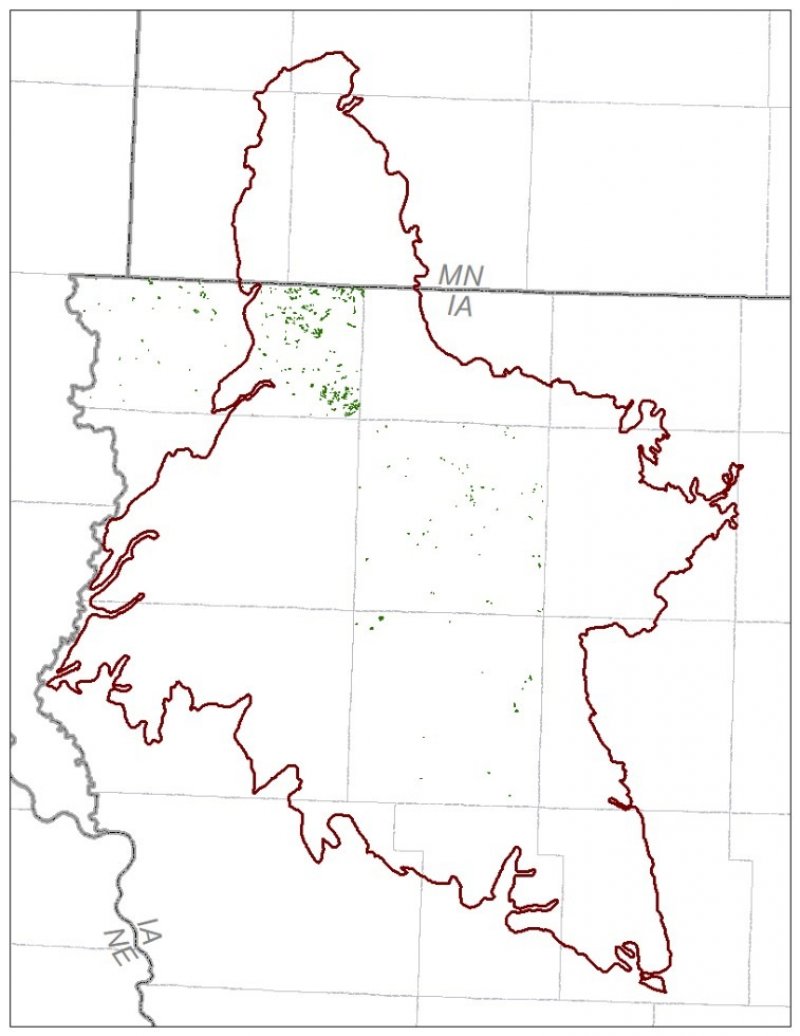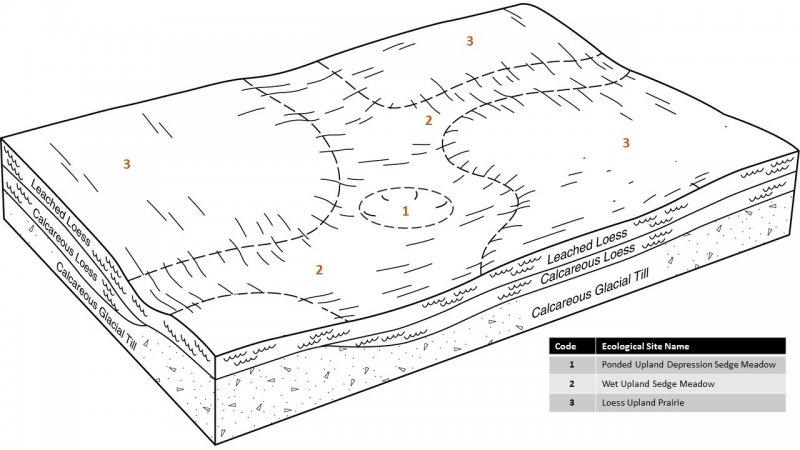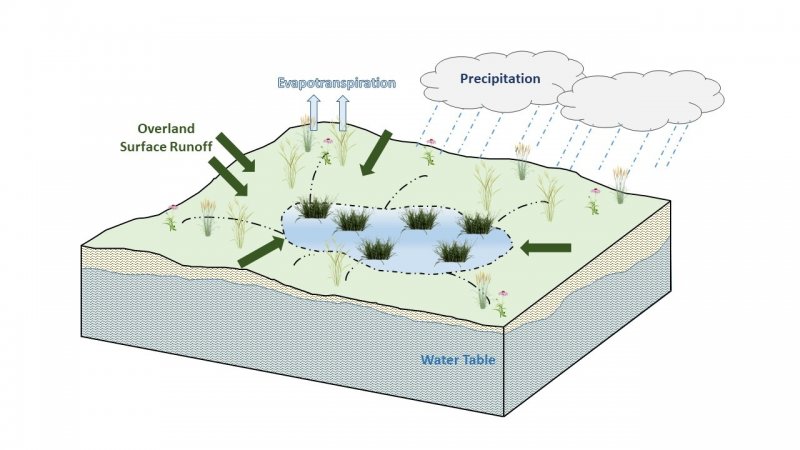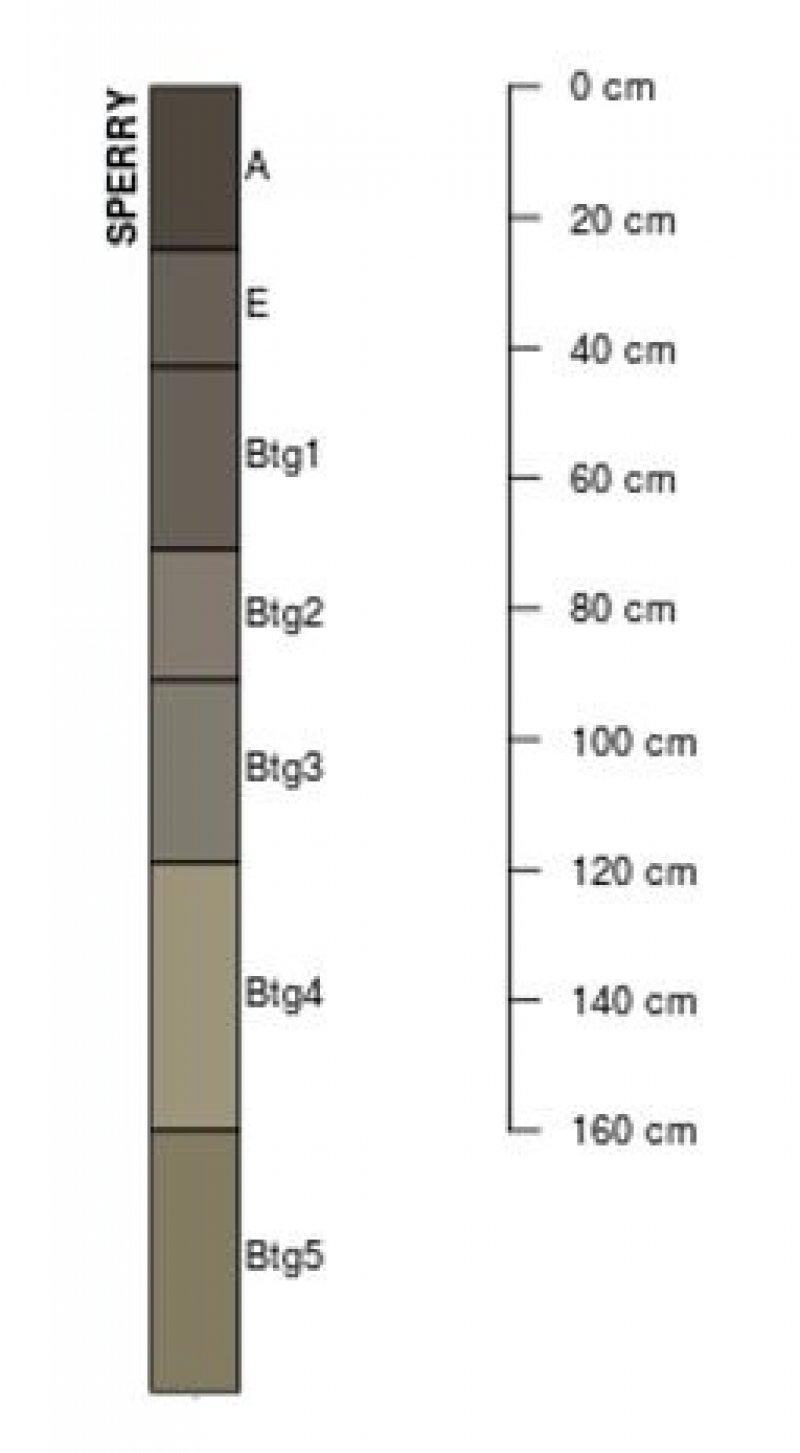
Natural Resources
Conservation Service
Ecological site R107XA208IA
Ponded Upland Depression Sedge Meadow
Last updated: 5/21/2020
Accessed: 12/21/2025
General information
Provisional. A provisional ecological site description has undergone quality control and quality assurance review. It contains a working state and transition model and enough information to identify the ecological site.
Figure 1. Mapped extent
Areas shown in blue indicate the maximum mapped extent of this ecological site. Other ecological sites likely occur within the highlighted areas. It is also possible for this ecological site to occur outside of highlighted areas if detailed soil survey has not been completed or recently updated.
MLRA notes
Major Land Resource Area (MLRA): 107X–Iowa and Missouri Deep Loess Hills
The Iowa and Minnesota Loess Hills (MLRA 107A) includes the Northwest Iowa Plains, Inner Coteau, and Coteau Moraines landforms (Prior 1991; MDNR 2005). It spans two states (Iowa, 89 percent; Minnesota, 11 percent), encompassing approximately 4,470 square miles (Figure 1). The elevation ranges from approximately 1,700 feet above sea level (ASL) on the highest ridges to about 1,115 feet ASL in the lowest valleys. Local relief is mainly 10 to 100 feet. However, some valley floors can range from 80 to 200 feet, while some upland flats only range between 3 and 6 feet. The eastern half of the MLRA is underlain by Wisconsin-age till, deposited between 20,000 and 30,000 years ago and is known as the Sheldon Creek Formation. The western half is underlain by Pre-Illinoian glacial till, deposited more than 500,000 years ago and has since undergone extensive erosion and dissection. Both surfaces are covered by approximately 4 to 20 feet of loess on the hillslopes, and Holocene alluvium covers the till in the drainageways. Cretaceous bedrock, comprised of sandstone and shale, lies beneath the glacial material (USDA-NRCS 2006).
The vegetation in the MLRA has undergone drastic changes over time. Spruce forests dominated the landscape 30,000 to 21,500 years ago. As the last glacial maximum peaked 21,500 to 16,000 years ago, they were replaced with open tundras and parklands. The end of the Pleistocene Epoch saw a warming climate that initially prompted the return of spruce forests, but as the warming continued, spruce trees were replaced by deciduous trees (Baker et al. 1990). Not until approximately 9,000 years ago did the vegetation transition to prairies as climatic conditions continued to warm and subsequently dry. Between 4,000 and 3,000 years ago, oak savannas began intermingling within the prairie landscape, while the more wooded and forested areas maintained a foothold in sheltered areas. This prairie-forest transition ecosystem formed the dominant landscapes until the arrival of European settlers (Baker et al. 1992).
Classification relationships
U.S. Forest Service Ecological Subregions: North Central Glaciated Plains (251B) Section, Outer Coteau des Prairies (251Bb), Northwest Iowa Plains (251Bd) Subsections (Cleland et al. 2007)
U.S. EPA Level IV Ecoregion: Loess Prairies (47a) (USEPA 2013)
National Vegetation Classification – Ecological System: Eastern Great Plains Wet Meadow, Prairie and Marsh (CES205.687) (NatureServe 2015)
National Vegetation Classification – Plant Associations: Carex atherodes Wet Meadow (CEGL002220) (NatureServe 2015)
Biophysical Settings: Eastern Great Plains Wet Meadow-Prairie-Marsh (4214880) (LANDFIRE 2009)
Natural Resources Conservation Service – Iowa Plant Community Species List: Wet Meadow, Awned Sedge (USDA-NRCS 2007)
Iowa Department of Natural Resources: Prairie Marsh (INAI 1984)
Minnesota Department of Natural Resources: WMs92a Basin Meadow/Carr (MDNR 2005)
U.S. Army Corps of Engineers: Sedge Meadows (Eggers and Reed 2015)
Ecological site concept
Ponded Upland Depression Sedge Meadows are located within the green areas on the map (Figure 1). They occur in upland depressions on slopes generally less than one percent. The soils are Mollisols that are very poorly-drained and deep, formed in loess. The site experiences occasional to frequent, brief to long ponding from precipitation, overland flow, and groundwater flow.
The historic pre-European settlement vegetation on this site was dominated by herbaceous species adapted to temporarily ponded conditions. Wheat sedge (Carex atherodes Spreng.) , common rivergrass (Scholochloa festucacea (Willd.) Link), and water knotweed (Polygonum amphibium L.) are the dominant species of Ponded Upland Depression Sedge Meadows. Other grasses and grass-likes that may occur include bluejoint (Calamagrostis canadensis (Michx.) P. Beauv), prairie cordgrass (Spartina pectinata Bosc ex Link), river bulrush (Bolboschoenus fluviatilis (Torr.) Soják), and common spikerush (Eleocharis palustris (L.) Roem & Schult.) (MDNR 2005; NatureServe 2015). Species typical of an undisturbed plant community associated with this ecological site include hemlock waterparsnip (Sium suave Walter), woollyfruit sedge (Carex lasiocarpa Ehrh.), and water sedge (Carex aquatilis Wahlenb.) (Drobney et al. 2001; MDNR 2005; NatureServe 2015). Depth and duration of ponding as well as periodic fire are the primary disturbance factors that maintain this site, while native large mammal grazing and drought are secondary factors (MDNR 2005; LANDFIRE 2009; NatureServe 2015).
Associated sites
| R107XA208IA |
Ponded Upland Depression Sedge Meadow Loess or loamy sediments on broad upland flats that do not experience ponding, including Gillet Grove, Letri, Marcus, Rushmore, Spicer |
|---|
Similar sites
| R107XA209IA |
Wet Upland Sedge Meadow Wet Upland Sedge Meadows are similar in landscape position, but site is a MINERAL SOIL FLATS wetland |
|---|---|
| R107XA210IA |
Wet Upland Drainageway Prairie Wet Upland Drainageway Prairies are similar in landscape position, but site is a SLOPE wetland |
Table 1. Dominant plant species
| Tree |
Not specified |
|---|---|
| Shrub |
Not specified |
| Herbaceous |
(1) Carex atherodes |
Click on box and path labels to scroll to the respective text.




